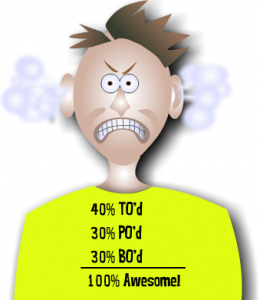 Humor Post #34 from Middle School’s Crankiest Curmudgeon’s Blog (and probably the awesomest YA blog too) –
Humor Post #34 from Middle School’s Crankiest Curmudgeon’s Blog (and probably the awesomest YA blog too) –
English is a great language, I’ll say that right up front. First off, it’s probably spoken by more people than anyone else in the world. Now Chinese might be catching up but I’m pretty sure that since they speak English in India, good ol’ English is still on top. Second off, stuff sounds good in English. Songs sound good in English, movies and TV shows sound good in English, my jokes sound good in English, and hey, what else is there that really matters?
But what I’m really getting at is even though English is cool, it could still use a bit of tweaking. Especially with a couple punctuation marks I’ll be talking about today. That would be the question mark and the exclamation point. I never thought much about these two little guys till I started taking Spanish. And it was there that I found out that Spanish speakers have got two things right that we really should copy.
And don’t go telling me we shouldn’t be copycats. (BTW, where did the word “copycat” come from? Cats can’t even write, much less copy.) We copied pizza and ice cream from Italy and China and I don’t hear anyone complaining.
So anyway to get my ADD brain back on topic, here’s the way we ask a question in English:
Hey, Joe, whatcha know?
And here’s how they ask the same question in Spanish:
¿Oye, José, qué sabes?
Do you see a big difference?
No, no, banana head, I can see that the words are different. I’m talking about the punctuation. Yeah, that’s it. They put an upside down question mark at the beginning of the Spanish question. Now why do I like that? Because it warns you that the next sentence is going to be a question, that’s why. Just last week we were taking turns reading out loud from this novel in English class. (Our teacher is big on getting us to practice our “public speaking voice.”) And I was near the end of this sentence that went something like, “And then you’re going to the market and you’re going to talk to Maria?” But I didn’t see the question mark till I was almost at the end of the sentence and it didn’t sound right. If someone had warned me a question was coming up, I could have been prepared. In Spanish, I would’ve been.
They also do the same thing with exclamation points. If you see an upside down exclamation mark at the beginning, you know you’re going to act excited for the whole sentence. Look at these two examples:
With English punctuation:
“I love you incredibly, so much that it makes my heart ache and my eyes tear up to look at you!”
With Spanish punctuation:
“¡I love you incredibly, so much that it makes my heart ache and my eyes tear up to look at you!”
See the difference? It’s huge! In the first one you could be using a romantic, sexy voice and you think you’re supposed to act all sad. Then you see that ending punctuation mark and you have to come to a screeching half on the mushy stuff and start yelling the last few words. Not good. But in the second sentence, you get that warning so you’re all excited right from the get-go. By the time you get to “heart ache,” you’re practically ripping your heart out of your chest and by the end of the sentence, that girl would need Noah’s Ark. Now THAT’S what you could deliver if you knew what was coming.
So, to all of you people out there who can read — and I hope that’s a good percentage of you — if you know who I can write to ask about making this a new grammar law, I’d really appreciate it. I was thinking of writing my Congressman, but my mom says Congress never gets anything done except giving themselves pay raises so that’s probably not the way to go. But who’s in charge of punctuation out there? Guess this’ll take some real research. Maybe the Mexican or Argentinian government can help me. Hope they speak English.
from your gifted gabber, your seeker of sagacity (ooh, sagacity, whoo-hoo!), your middle school master of merriment,
Dr. Crankenfuss, the Dude with the ‘tude